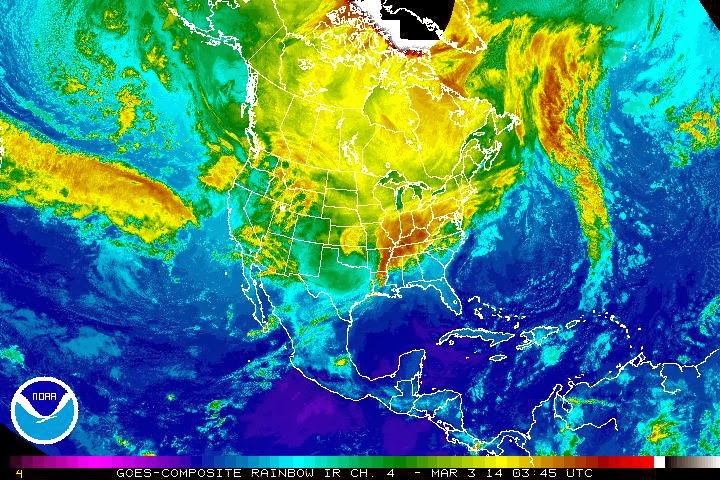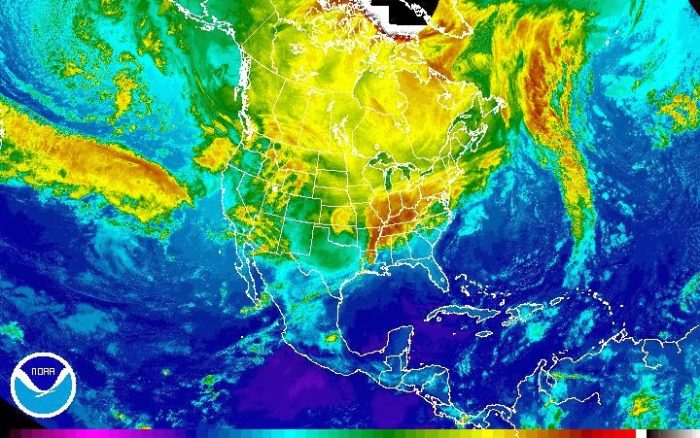 |
| https://www.ssd.noaa.gov/goes/comp/nhem/rb.jp |
Some years ago I met Michael Presley at a native plant conference held at the Summerfield Waldorf School in Santa Rosa, CA. Michael presented on how to use native medicinals in landscaping, but the talk was ever so much more. It quickly became apparent that this was a man of process, an individual who looked at the wider health of the land, restoring springs, affecting microclimates through planting, and using goats to replicate the native tule elk who would have frequented the West County forests in earlier times. Michael explained how goats, properly browsed, re-established native plants. Donald and I were delighted when he and his wife Katherine moved to Napa this last summer. The following is an interview on the drought with this multitalented man.
Patricia: Michael, what is your background and how did you come to be interested in weather?
Michael: I became interested in weather as a young boy watching the cloud formations and storms develop over the Santa Cruz mountains and rain on our apricot farm in Los Altos. I had a paper route for the San Francisco Chronicle, 100 houses, so I would watch the weather report every evening to see what my 6 am delivery would be like. They showed a satellite cloud image video loop for about 5 seconds and then a lot of gesturing about the highs & lows and percentage chance of rain. They were usually wrong. My frustration turned into a deep curiosity about how the weather worked. I loved the big storms, floods, droughts, rare snow storms, frosts and everything which I experienced on my bike delivering papers. I also loved riding my bike after school up to Skyline Road on the ridge and looking over the Pacific and observing the advection fog ripping over the hills. It was so dynamic and beautiful.
I was good at mathematics and physics so I chose to study atmospheric science at UCLA in the late 70’s. I launched weather balloons every morning at 6 am for the Air Quality district off the roof of the Math/Earth Sciences department and became very intimate with the inversions and wind shears of the LA basin. I got a multi dimensional feeling for the air masses as I tracked the balloon to 20 thousand feet. El Nino hit us hard there in 1980-81, with massive storms and ocean waves. I was in heaven watching nature rule that urban setting.
I did graduate work for NASA/JPL doing early satellite data evaluation over the ocean surfaces, drawing wind streamlines with high resolution data. It was the perfect blend of science and art. The patterns were so beautiful: the vortexes, frontal systems, hurricanes, high pressure ridges, all looked like the indigenous art of the Maori wood carving.
At that time the science of numerical modeling and big computer data systems was being developed at UCLA. The older generation synoptic weather gurus from WW ll era pilots were transferring their wholistic knowledge of the atmosphere for the development of these forecast models. There were some great map discussions and fevered arguments which I’ll never forget. I came away with such a lucid perspective of how the atmosphere behaves that I just had to go work in the weather instead of looking at it in the digital computer form. So I studied biointensive gardening at the Farallones Institute in Occidental, California, and have never left the garden now for 32 years. I have gardened on the coastal hills of Sonoma, Marin and now in Napa Valley. I also gardened on Big Island Hawaii for three years during the Kilauea eruptions of the early 90’s.
Patricia: How do you understand the drought?
Michael: Weather is the microcosm of the climate macrocosm. It is hard to understand Climate Change because its time frame is so much like geology. The climate of this region of California has been everything from tropical, subtropical, desert, temperate, Mediterranean and edge of glacial, all within the last 100,000 years. There is no normal here; it is always changing, plant species, animal species, all fluctuating with the changes. The fluctuation is dependent on the sun, our solar system, and even forces we do not know of which pulse out of our galaxy. I view climate as the resonant frequency of all physical forces of influence at that place. The change of climate can be slow and progressive or immediate, as in the case of the asteroid hit of the Pleistocene era.
We are pouring gasoline on an already existing change. Our release of CO2 is pushing the energy of heat into the amplitudes and frequency of the massive atmospheric waves we call weather. We will experience more extremes in all ways as the atmosphere works to find a new resonance or climate regime.
I love the way David Suzuki describes the membrane of atmosphere on Earth as a pulsing layer the thickness of saran wrap on a basket ball, continually trying to resolve the polarity of cold and hot on a spinning wet and dry earth. What a fine balance and continual change simultaneously!
Patricia: Do you think there is a spiritual component to drought?
Michael: This drought is a very important wake-up call for the behavior of us humans. It is a spiritual issue for us: can we change our material and consumptive behavior to find a more peaceful and harmonious relation with Nature? With a population of 7 billion, that would require a spiritual awakening and practical/cultural shifts for everyone. Adaptation and evolution are hardwired in all of life; the question for us will be: can we change, soon? I find hope in the movements of Bioneers, Permaculture, Biodynamic farming, biomimicry, which are asking questions of nature and learning new tools and behaviors which bring us closer to our potential as stewards and cultivators of healthy living systems on an appropriate scale.
We are addicted to fire. Everything we do requires some form of burning. Even drinking water requires the energy of fire to collect, store, distribute. As we burn, the water recedes into vapor, driving weather patterns into a frenzy to dissipate the heat through condensation and freezing, but the CO2 is still there absorbing more heat like a sponge. We are on a long multigenerational journey of climate change, and currently we are pushing the intensity and rate of change onto our children’s children.
Patricia: What are the important questions that we collectively should be asking about water?
Michael: On a small scale of backyard and community gardening, it will be important to secure water through catchment, infiltration, mulch, drip irrigation, plant selection for drought tolerance, heat tolerance, freeze tolerance, etc. In large food systems we will need to turn to polycultures, systems which integrate perennials, annuals, animals, no till, dry farming techniques. Innovation in these ancient and indigenous technologies is on the front burner, so to speak, but we will have to be resilient and adaptive within these systems. We are heading into some very interesting times. I hope the change is for the better.
Patricia: Has being a climatologist changed the ways that you approach water and the use of water?
Michael: Water is being discovered to be much more than a material element. Current research by Gerald Pollack at UW and Mae Won Ho of ISIS and many others worldwide are discovering a fourth phase of water called ‘quantum coherent’ or ‘structured’ water. Nano technology is measuring energy and organization within water which is capable of storing information through its plasma sheaths 1000 times greater than that of silica chips. Indeed, the work of John Wilkes and the flowform technologies have been understanding this level of water as conscious, or spiritual in nature.
So as science and spirituality are speaking the same language, the question becomes, what is water telling us? How do we treat water as a living being instead of a commodity? How do we honor every drop of rain that falls and help guide it into as many healthy organisms as possible? How do we slow water down so it can wiggle its energy and life giving properties into our local nature, gardens, and our own bodies? How do we turn our fires down and condense more vapors? How do we sequester more carbon dioxide into our trees and soils, scrubbing the atmosphere? How are we going to feed more people with less? How are we going to grow more young farmers to innovate and collaborate on solutions to the problems facing us today and intensifying into the future?
Patricia: Are there things that you are doing differently given the dire situation here in California with rivers and with water supply?
Michael: I am planting potatoes and carrots this new moon after these wonderful rains. Learning to respond before reacting will be my practice.
